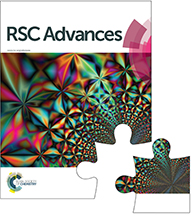Highly sensitive optical temperature sensing based on pump-power-dependent upconversion luminescence in LiZnPO4:Yb3+–Er3+/Ho3+ phosphors†
Abstract
In this work, various LiZnPO4:0.5 mol% Ln3+ (Ln = Ho, Er) phosphors with different Yb3+ ion doping concentrations were synthesized by a sol–gel/Pechini method. X-ray diffraction (XRD) and scanning electron microscope (SEM) techniques were used to evaluate the phase and morphology of the samples. The UC process was mentioned as the typical emission peaks of Er3+ and Ho3+. For Er3+ and Ho3+, different optical temperature sensing methods are included. The Boltzmann distribution was accompanied by the fluorescence intensity ratio (FIR) for the two green Er3+ emissions originating from thermally-coupled levels. The effect of pump power on sensor sensitivities was extensively studied. The temperature uncertainty is also evaluated. The red and green emissions generated from non-thermally-coupled levels were used for temperature sensing in the Ho3+-activated LiZnPO4. High sensitivities were obtained in the phosphors, and the LiZnPO4:Yb3+/Ho3+ showed the largest absolute sensitivities. LiZnPO4:Yb3+–Er3+/Ho3+ phosphors may be useful in the development of new luminescent materials for optical temperature sensing.



 Please wait while we load your content...
Please wait while we load your content...